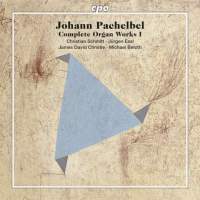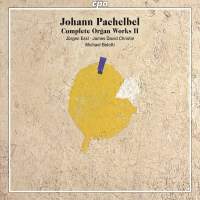Texte paru dans: / Appeared in:
|
|||||||
|
Outil de traduction ~ (Très approximatif) |
|||||||
|
Reviewer: These two volumes present the first seven CDs of what will be a 10-disc series of the complete organ works of Johann Pachelbel (1653–1706). Pachelbel of course has the good or bad fortune (depending on your view of the matter) of being known to a broader musical public for two short earworm pieces, the Canon and the Gigue (T 337). (It was a real ear-opener for me to hear this played by Andrew Manze and the London Baroque in a terrific period instruments recording, rather than the souped-up modern string orchestra arrangement purveyed by Jean-François Paillard, and learn that, yes, it actually is quite a good and intriguing piece of music.) However, despite his considerable reputation during his lifetime, it is only recently that much of his extensive corpus of compositions in many genres (over 200 organ pieces and over 100 vocal works) has begun to be published systematically in critical editions. Pachelbel’s life is unusually well documented for his era. He was born in Nuremberg into a middle-class family (his father was a wine dealer). He received his initial schooling and education there under Georg Caspar Wecker (1632–1695), and then went to university, first in Altdorf and then in Regensburg, a transfer prompted by financial hardship (the latter institution, impressed by his abilities, admitted him above its maximum student quota and awarded him a scholarship). There he studied with Wolfgang Caspar Prentz (1641–1717), a pupil of Johann Caspar Kerll (1627–1693), who in turn had absorbed Transalpine musical innovations from figures such as Giacomo Carissimi (1605–1674) and his first teacher, Giovanni Valentini (c. 1582–1649); Prentz transmitted this influence and interest to Pachelbel in turn. From 1673 to 1677 Pachelbel served as deputy organist at the prestigious Stefansdom cathedral church in Vienna, where he likely would have made contacts with several leading musical figures of the era. It is possible but not certain that he studied directly with Kerll there; he did use Kerll’s works as models for his own compositions. After a one-year stay with the ducal court in Eisenach, where he was befriended by the Bach family, Pachelbel moved to Erfurt in 1678 to become organist of the famed Predigerkirche (which I had the privilege of visiting in 1988). He remained there for 12 years, establishing a reputation as one of Germany’s leading organists and continuing his friendship with the Bachs: He lived in a house owned by Johann Christian Bach (1640–1682), was tutor to Johann Christoph Bach (1671–1721), and became godfather to Johanna Juditha Bach, daughter of Johann Ambrosius Bach (1645–1695) and sister of Johann Sebastian Bach. After Johann Christian died, Pachelbel bought the house from his widow. He initially married in 1681, but his wife and son died of the plague two years later. In 1684 he remarried and subsequently had five sons and two daughters; two of the sons became organists themselves, and one of these two migrated to the American colonies in 1734 and became a leading figure in the life of Charleston, South Carolina. In 1690 Pachelbel left Erfurt to accept a financially more remunerative position with the ducal court of Württemberg in Stuttgart. The move proved to be singularly ill-timed; two years later he was forced to flee when France invaded the duchy in a war, and he ended up in Gotha as town organist until 1695. In 1694 he may have traveled to Ohrdruf for the wedding of his onetime pupil, Johann Christoph Bach, an occasion to which he at least contributed music; if so, he would have met an 11-year-old Johann Sebastian, the only possible direct encounter of the two in their lifetimes. In 1695 Pachelbel finally made his way back to his home city of Nuremberg and an appointment as organist at the St. Sebalduskirche, succeeding his early teacher Wecker, where he would spend the final 11 years of his life. Despite being recognized as one of Germany’s finest organists, Pachelbel did not attract prestigious pupils or exercise extensive influence as a composer, so his reputation quickly faded after his death, being overshadowed by his contemporary Dieterich Buxtehude. Hearing the music in this set, one can understand why, while still regretting the previous neglect and rejoicing in its rectification here. While Pachelbel was indeed a very accomplished composer, he did not have the special spark of highly original creativity that one finds in Buxtehude, let alone Bach. In particular, he was a figure who seems to have looked backwards more than forwards. Stylistically, in melody and harmony, his works remain akin to those composed in the early Baroque and even the late Renaissance, even as sometimes he poured the old wine into new bottles by taking up the more recent musical forms imported from Italy. Much of this may also be due to the fact that virtually all of his organ music has direct liturgical functions, in contrast to the more autonomous fugues of Bach; most congregations, and the town fathers who oversaw and regulated many aspects of church practice and discipline, would have had conservative inclinations.
The seven discs in these two
volumes each have a thematic organization, as follows: Volume 1 – CD 1: The Church Year – Easter to Michaelmas CD 2: Psalter Songs, Part 1 CD 3: Catechism Songs and Other Pieces, Part 1 CD 4: Catechism Songs and Other Pieces, Part 2
CD 5: Hexachordum Apollinis Volume 2 – CD 1: The Church Year – Christmas CD 2: Catechism Songs and Other Pieces, Part 3 The two major musical forms which predominate in these pieces are the chorale and the fugue. Many of the former are written for manuals only with no pedals, since they accompanied congregational singing. As for the latter, while Pachelbel was an important figure in the development of the fugue, his pieces in that form are significantly shorter and less complex than their counterparts by Buxtehude and Bach. (The longest single track in the entire set is only 8:12, and the majority are less than five minutes in length.) Pachelbel was also fond of writing variations; the Hexachordum Apollinis (for either organ or harpsichord) is a set of six arias and variations in different keys that he dedicated jointly to Buxtehude and Ferdinand Tobias Richter (1651–1711), a friend from Pachelbel’s Vienna years. All the works here are performed on various historic 18th-century church organs in Germany (Bedheim, Simmern, Suhl, and Wolfegg), Switzerland (Lucerne and Rheinau), and Austria (Vienna). Their realizations in every instance are exemplary; all of the instruments are splendid, though I prefer the ones in Lucerne, Simmern, Vienna, and Wolfegg to their counterparts in Bedheim, Rheinau, and Suhl, as appearing to have richer tonal palettes and especially more powerful and pungent pedal registers. I likewise have no strong preference between the organists, who play with great unanimity of style, though Michael Belotti (a German despite his Italianate last name) has a special degree of authority here as the editor of the new series of Pachelbel’s complete keyboard works being published by Wayne Leuphold Editions. All of the instruments are ideally recorded, with their distinctive acoustic environments also being well preserved. While CPO always produces exceptionally detailed booklets, here it has really gone the extra kilometer (being in Germany and not the USA) in providing not only all the specifications for each organ, along with numerous photos, but also lists of the exact stops used to perform each individual piece. I also appreciated the photos of all four organists gathered together in collegial camaraderie (though where is not specified). The only incredibly tiny thing at which I can cavil is that Volume One is issued in a cardboard box, whereas Volume Two comes in a plastic slimline jewel case, so the casings of the two sets do not match. I presume that the remaining discs will be issued together in a single volume. I will look forward to it with eager anticipation as the capstone to a splendid series. Urgently recommended to both organ lovers and to fans of Baroque music generally. James A. Altena
| |||||||
|
Support us financially by purchasing this disc from eiher one of these suppliers. Un achat via l'un ou l'autre des fournisseurs proposés contribue à défrayer les coûts d'exploitation de ce site. |
|||||||
|
|
|
||||||
|
Cliquez l'un ou l'autre
bouton pour découvrir bien d'autres critiques de CD |
|||||||





